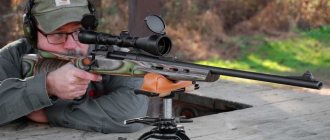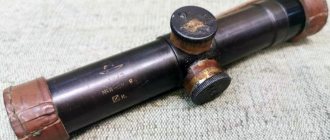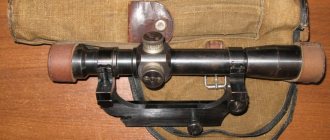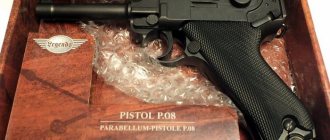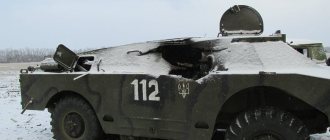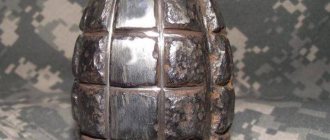What is a laser rangefinder
A laser rangefinder is an optical-electronic device for measuring distance. Several decades ago, such devices could only be used in large observation and fire control systems - tank and artillery crews.
Improvements in technology have led to laser rangefinders being used for various domestic and professional purposes. They are often built into observation and measuring devices - surveying devices, optical sights, binoculars and telescopes.
Additional information on the grid
Let's take a closer look at the last picture.
The scale is shown in the upper right corner. In this case (for this reticle only!), this is the distance between points in thousandths of distance (MILs or MRAD) at a given magnification. We have already calculated this figure above in the “Maximum multiplicity” section - 0.66 MRAD
Accordingly, at a multiple of 10, the scale should be equal to one.
Let's look at the lower left quarter of the grid. This shows the distance between points in centimeters at the current distance (100 meters) and at the current (in this case, maximum) magnification. Of course, at a distance of 100 meters it is exactly equal to 6.6 centimeters. The program rounds to 7, since in this case this is enough to see (and understand), for example, that the bullet hit lower or to the left by 7 (14, 21) centimeters.
Setting up the calculator for the Hawke Panorama EV 4-12×40 sight
New! Setting up the calculator for the Guardian 2-20x44SFIR sight
Advantages of an optical sight with a rangefinder
Ideally, the shooter doesn't have to worry about target distance, wind speed, or humidity. He can receive this data from the competition organizers or a partner if the shooting takes place in combat conditions.
Practice shows that a shooter often acts alone or as part of a group of comrades - the same shooters. To make the most accurate shot, you have to estimate the distance to the target yourself. The most convenient way to do this is to use an optical sight with an integrated rangefinder. The use of such a sight allows you to quickly:
- introduce vertical corrections for the firing range;
- knowing the wind speed, calculate lateral corrections or shoot ahead;
- use a ballistics calculator that automatically calculates the offset of the midpoint of impact, depending on the ammunition used.
Setting up a ballistic calculator
Let's take an air rifle and “launch” a bullet with a ballistic coefficient of 0.026 from it at a speed of 275 m/sec. The rifle was sighted at 50 meters.
If we did not check the magnification, then the settings and the reticle screen with corrections (at maximum magnification) would look like this:
And these are the correct grid settings:
Compare the lowest correction. 108 and 111 meters. For this bullet, this is a difference in height of 6 centimeters. For a small target - a guaranteed miss.
How distance is measured (working principle)
Scheme of laser rangefinder operation
There are two ways to measure distance using a laser: pulse and phase. In both cases, a laser with a fixed wavelength, located in the visible or infrared range, is used.
The operating principle of a pulse rangefinder is to emit laser radiation in short pulses. When the beam is aimed at an object, it is partially reflected back, which is recorded by the rangefinder detector.
The distance to the target is calculated as the product of the speed of light and the time elapsed from the emission of the beam to the recording of its reflection, divided by two.
The advantage of the pulse method is that there is no fundamental limitation on the distance being measured. In the domestic sphere, such rangefinders are practically not used. This is due to the difficulty of measuring the time interval (nanoseconds) that a laser beam takes to travel a short distance.
The phase rangefinder is used much more widely in everyday life and has become widespread in binoculars, monoculars and optical sights. Its operation is based on high-frequency modulation of the emitted signal. When reflected from an obstacle, the beam returned to the detector differs from the original radiation by a phase shift (from 0 to 2?).
The fixed shift strictly depends on the distance traveled. The fundamental limitations on the measured distance can be expanded by changing the modulation frequency. To determine the distance at an aimed shot distance (up to 1000 m), the modulation frequency should not exceed 150 kHz.
Despite the obvious advantages of laser rangefinders integrated into the design of optical sights, some limitations of their use should be noted:
- difficulty in measuring the distance to a moving target;
- narrow angular parameters of the object;
- operation during precipitation;
- mirror or black target surface;
- measurement above the water surface.
It is better to entrust the repair of the sight to a specialist, but if he is not nearby, we take matters into our own hands. In this article we will learn how to repair an optical sight with your own hands. Lenses, springs, lubrication, backlight repair, etc. Do you need a permit to buy the most powerful air gun? You can find out more about this in this article.
So the bullet flew and...
Relatively recently, devices came to the market that combined not only a sight and a rangefinder, but also a built-in ballistic calculator.
In Russia, for a long time, rangefinder scales on optical sights and binoculars were used to determine distances. However, this method, despite its simplicity, is not sufficiently accurate and reliable. In addition, the observer needs a landmark with pre-known dimensions, which is a difficult condition if, for example, you are in an open field.
A simple way out of this situation is to use portable laser rangefinders. The principle of their operation is simple. The device uses a laser to send pulses that are reflected from the target. The receiver receives the reflected pulses, then the built-in microprocessor calculates the distance depending on the time the pulse was sent to the target and until the moment its reflected signal was received.
Lasers installed in rangefinders operate in the infrared wavelength range, and their radiation is not visible to the naked eye. Despite the fact that modern civilian laser rangefinders use safe Class 1 infrared lasers, all manufacturers strictly prohibit pointing the switched-on devices at people: this can lead to eye injuries, especially at close distances.
Leica and then Swarovski introduced laser rangefinders to the market in 1992. A little later, Swarovski offered a rangefinder model integrated into an optical sight. However, the cost of these devices (several thousand dollars) was very high.
Laser rangefinders have become available to the general consumer only since 1996. At the same time, Bushnell offered the market relatively inexpensive devices. Since then, other optical companies have begun to actively work in this direction. Among them are Nikon (Japan) and Newcon (Canada).
But at the moment, according to foreign press reports, only Bushnell has managed to seize a leading position: it owns up to 95% of the market in the United States, the main consumer of such equipment.
| BALLISTIC CALCULATOR. The ballistic calculator has many faces. It can be integrated into standard optical devices, such as monoculars, binoculars or optical sights, or it can exist as a separate device, however, the price for it will be inexplicably high. The ballistic calculator can also be in the form of a separate program installed on a smartphone, telephone or laptop computer. Its simplest version is an ordinary table of bullet drop depending on distance, which the cartridge manufacturer usually prints on the packaging. |
In the USSR (and later in Russia), rangefinders were available only to the military. And military models use lasers so powerful that if their rays hit the retina of the eye, a person can lose vision, so under no circumstances did they enter the civilian market.
Unfortunately, the domestic industry is not yet able to offer competitive rangefinders for civilian use, and one has to choose from devices from foreign companies.
All rangefinders available on the market can be roughly divided according to price range into approximately 3 groups. The first, up to 20,000 rubles, includes medium rangefinders from companies such as Bushnell, Newcon, with the ability to measure distances up to 400–600 meters. They are quite suitable for hunting.
The second group, up to 50,000 rubles, includes devices from more serious manufacturers, such as Leica and Swarovski, with the ability to measure up to 1200 meters. In addition to the fact that they are “long-range”, the accuracy and speed of their measurements is very high.
The third group, up to 80,000 rubles, includes rangefinder binoculars from the same brand manufacturers. There are also expensive professional devices (for example, Leica Vector IV) capable of measuring distances up to 4000 meters, which is unlikely to be needed by hunters.
| A ballistic calculator can be either a program or a separate device installed directly on the sight. |
The maximum operating distances of rangefinders declared by manufacturers are conditional.
There are two groups of factors that influence the rangefinder’s performance: target quality and external atmospheric conditions. The laser rangefinder achieves its greatest effectiveness on targets that have the maximum reflective effect. In other words, the ideal object for a laser beam would be a large mirror located at an angle of 90° to its plane, and the worst would be a small tennis ball painted matte black.
Another group of factors are external. And first of all, this is lighting. In sunny weather, the efficiency of the laser decreases, and in the dark it increases.
Atmospheric interference in the form of rain or snow, bushes or trees located in the direction of the target also lead to distorted results. A number of devices have a “Rain” mode, which allows you to ignore false targets.
| Today, many companies produce rangefinders that not only measure the apparent distance, but also calculate the horizontal component. |
| It’s not enough just to determine the distance to the target - today, advanced devices are able to independently calculate the amount of correction for your rifle. |
The focus of the laser beam is also of great importance. If the size of its spot is much larger than the size of the target, then the reflected radiation may not be enough to determine the distance.
And finally, the operation of the rangefinder depends on the quality of the batteries: with “dead” power sources, the laser cannot give the required impulse.
To the above, it should be added that if the object is small in size and located further than 400 meters, then it is better to measure it from a tripod (in extreme cases, you should rest your elbows on some surface). This is due to the difficulty of hitting an object with a beam at long distances due to hand tremors.
In some cases, at distances greater than 200 meters, it becomes difficult to catch the reflected signal from the object, and the devices either do not give any results or give the distance to the background. In such situations, the scanning function helps, in which the device takes continuous sequential measurements and constantly displays the next result.
I would like to say a few words about optics. Newcon, Nikon and Bushnell companies show approximately the same image quality, sufficient for distance measurement purposes.
However, Leica's picture quality is simply excellent: the brightness is an order of magnitude better than other devices, and the picture is crisp and clear and virtually free of distortion.
In general, Leica rangefinders today are clearly leaders in both quality and capabilities. They have a sealed housing filled with inert gas. Measurement data is displayed in the field of view in the form of luminous numbers, which is very convenient when working in the twilight.
As is known, the vertical decline of a bullet in flight depends on the time it spends on this flight. The force of gravity acts on the bullet vertically downward, and it does not matter at what angle it flies to the horizon.
Thus, the absolute reduction of a bullet depends only on how long it takes to cover the distance to the target, i.e. what distance will it travel, figuratively speaking, relative to the ground, and not relative to the air. This distance is what the rangefinder can immediately display.
| The Leopold RX-IV is one of the rangefinders that features a built-in ballistic calculator. |
| A monocular cannot replace a full-fledged optical device, so rangefinders and ballistic calculators began to be installed in binoculars. |
An interesting option for a rangefinder is its combination with an optical sight. Of course, it is attractive to get two devices in one housing at once. However, relatively recently, devices came to the market that combined not only a sight and a rangefinder, but also a built-in ballistic calculator.
One of the first affordable sights was the Burris Eliminator 3.5-10x40. Its design provides not only for measuring distance, but also for making automatic corrections.
In order for the sight to work correctly, you must select one of the groups of calibers, which is given in the description. The point is that the developers calculated the conjugate trajectories of various calibers and divided them into several groups.
As a result, we did not get a trajectory for a specific cartridge, but a close trajectory with deviations sufficient to hit the target. This scheme works great at hunting distances.
So, by shooting your weapon at a hundred meters and selecting the required group, you can easily hit a target at a distance from 0 to 400 meters. In my experience, a .223 caliber rifle with the above sight in the hands of a completely untrained shooter could easily hit gongs at a distance of 50 to 350 meters.
In general, I would like to dwell a little more on ballistic calculators. Interest in them is growing as long range shooting becomes more popular.
All ballistic calculators can be divided into several groups. The first includes programs built into devices with a rangefinder. These can be monoculars or binoculars. These same programs can be integrated into sights, as described above. But they don't consider the ballistics of a specific ammo or rifle.
All cartridges are divided into groups, and when zeroing, the shooter simply selects the desired group. This approach makes it possible to obtain satisfactory results for most calibers at distances up to 350–400 meters. This is more than enough for any hunt.
Shooters who want to shoot at long distances need more accurate tools, since in such shooting everything matters: the weight of the bullet, its speed, the ballistic coefficient, and the length of the barrel.
It must be taken into account that when firing the same cartridge from different barrels, the bullet speed will differ, and even this slight difference will be significant at distances of more than 600–700 meters.
That is why long-range shooters use programs that are able to calculate the trajectory of a bullet taking into account the maximum number of parameters, such as caliber and weight, ballistic coefficient, bullet speed from a specific weapon, sight height, ambient temperature and humidity, etc.
The accuracy of the calculation is amazing. Experienced shooters are able to hit targets at long distances with the first shot. The programs themselves usually look very simple and are installed on mobile computers, handhelds or even cell phones.
As we can see, to use them you need a thermometer, a barometer, a wind speed meter, and when shooting, it is advisable to measure the true speed of the bullet. And most importantly: in order to hit the target, you will subsequently have to shoot with the same cartridges.
| Binoculars with a built-in ballistics calculator are a great assistant for the shooter. |
| The only advantage of monoculars is their compact size. |
Does a shooter or hunter need a rangefinder and ballistic calculator? Of course yes, if a person uses rifled weapons. Another thing is which model to choose and how to use it.
Determining the distance to a medium-sized biological object (wolf, wild boar) is possible at distances of up to 300–500 meters. For modern rifled hunting weapons, this is the upper limit of application. Any device with a built-in ballistic calculator will do.
Another thing is that the hunter should measure the distance not only to the target that appears. It is advisable to stand on the number and measure the distance to clearly visible landmarks - a tree, a haystack, a bush, etc., so that when an animal appears, you can focus on them.
The use of scopes with built-in ballistic calculators is still new, but I think that with their prices dropping, many hunters will want to “not bother” with manually entering corrections, and since the device does it itself, they will prefer to just shoot, quickly and accurately.
Alexander Kudryashov August 31, 2015 at 12:16 pm
Review of several models
Burris Eliminator II 4-12 x 42
Burris Eliminator II 4-12 x 42 riflescope with rangefinder
The sight is a high-tech development and combines not only an optical system and a rangefinder, but also a ballistic calculator. After entering data into it, the aiming point is highlighted in the field with a red marker, which greatly facilitates aiming.
Sight characteristics:
- maximum operating range – 770 m;
- range measurement step – 1 m;
- zoom range – 4-12?;
- operating temperature range – (-17) – (+60) °C;
- The remote control unit for the sight is mounted on the forend;
- The manufacturer’s warranty for the optical circuit is lifetime, and for the electronic unit and rangefinder – 3 years;
- cost - about 55,000 rubles.
- range measurement range – 30-700 m, in 1 m increments;
- increase – variable, 2.5-10?;
- there is a function for measuring true and horizontal distance (for shooting at targets above or below the shooter’s level);
- waterproof housing (the sight cannot be used underwater);
- filling the housing with dry nitrogen , which prevents fogging from the inside when the temperature changes;
- price - about 35,000 rubles.
This model is distinguished by the ability to mount on any type of weapon equipped with a Picatinny rail and its high resistance to mechanical stress. This is quite convenient when using powerful ammunition, which can throw off the settings of more sensitive devices.
You can see the practical use of the model in the video:
The use of automatic calculation of the average point of impact greatly facilitates aiming, but the habit of using a ballistic calculator can have a detrimental effect on the shooter’s skills. A person accustomed to using a rangefinder and computer will find it difficult to navigate when the equipment is turned off (dead battery, unsuitable weather conditions, etc.).
Nikon Monarch L700
Nikon Monarch L700 optical sight with rangefinder
The model is designed for installation on air guns and firearms. Main characteristics of the sight:
You can get acquainted with the practice of using the sight, its appearance and features of use in this video:
Externally, the design of the sight makes a good impression and does not seem overly fragile. For zeroing, the ability to reset the settings has been introduced, which is convenient when used occasionally. Despite the rather high cost of this model, its purchase is significantly cheaper than similar sights from more well-known manufacturers.
Case 1. Reticle in the second focal plane.
Take, for example, the Leapers 4-16×40 Tru Hunter IE SCP-U4164AOIEW. The manufacturer declares that this sight has a Mildot reticle in a rather exotic design, when on each side of the center the reticle has 9 dots, and not 4, like the classic one. As is known for the MilDot grid, the distance between points should be equal to 10 centimeters at a distance of 100 meters, which is one thousandth or one milliradian (MRAD). Since the reticle of this scope is located not in the first, but in the second focal plane, the angular size of the reticle changes with changes in magnification and MilDot is true only at one magnification. The manufacturer declares that at a multiple of 10. This means that it is at a multiple of 10 that the distance between the points is 1 MRAD. In other words, the grid is calibrated to a power of 10. Or the grid is true at a power of 10. Let's call it the “base power.”
The manufacturer also declares that the minimum magnification of the sight is 4, and the maximum is 16. Let’s check?
What to pay attention to
Not all features are equally important to hunters—some are promoted by rangefinder manufacturers for promotional purposes or are important in other areas. For example, for a high-altitude installer, it is important to determine the distance between posts with an accuracy of half a meter, but for a hunter, most often an error within 5 meters is acceptable.
Here's what to look for when purchasing first:
- Measuring range
The range of a shot on a hunt rarely exceeds 300 meters, so for most hunters even the simplest and cheapest models of rangefinders, the measurement threshold of which is up to 500 meters, are suitable. However, with the proliferation of expensive high-precision rifles and digital sights (including thermal imaging) with high magnification, a confident shot can be made at distances of about 1000 meters! For such powerful lasers, not only the range is important, but also the size of the light spot at this distance - see point 3.
- Measurement accuracy
Accuracy is an important parameter of a measuring instrument. Most laser rangefinders have no problems with this. Several entry-level models have an accuracy of 5 meters per kilometer, but the rest determine distances with an accuracy of less than a meter. This level of accuracy is enough to calculate and make corrections for bullet drop.
- Divergence
There are no ideal lasers. The light spot of the optical emitter increases slightly at a distance. This phenomenon is called divergence. The amount of beam divergence can be measured in degrees, meters or other units, but in artillery it is common to use thousandths of a radian or simply “thousandths”. The fact is that a deviation of “one thousandth” at a distance of a kilometer is about a meter. Very convenient for mental counting.
The laser divergence is relatively small and ranges from fractions to several milliradians. To make it clear, a value of 0.5 mrad means that the light spot at a distance of 100 meters has a size of 5 cm. This is a very important parameter when taking into account the dimensions of a distant target, for example, a wild boar, bear or deer.
- Lens magnification
The optics of hunting rangefinders usually have a magnification of 6x - 8x. This is quite enough to observe the animal and determine the distance within a kilometer. Stronger magnifications are used only in military models or special-purpose devices that weigh tens of kilograms.
- Lens diameter
The larger the lens size, the higher the aperture ratio, and therefore the ability to observe the target in low light. Popular models of laser rangefinders for hunting have optics Ø 20-30 mm. A diameter that is too large is also not good, because the device loses its compactness and becomes heavier.
It is worth noting here that in most rangefinders the combination of magnification and lens diameter gives a small viewing angle and aperture ratio. Even at dusk, the LCD display information merges with dark objects. If you plan to conduct observations and measurements late in the evening, then it makes sense to buy a rangefinder with a backlit display function, and if at night, then it makes sense to choose rangefinders with a night vision function.
- Weight and dimensions
Unlike military ones, laser rangefinders for hunting weigh no more than 400 grams, are small in size and easily fit in a jacket pocket. You need to choose an ultra-compact model when you save every gram, for example, in the mountains.
- Battery life
Manufacturers guarantee continuous operation time without replacing batteries of 8 - 10 hours. In reality it turns out more. The fact is that energy is spent mainly by the laser, and it is not turned on often. In severe cold, the battery capacity decreases, so it is better to keep the device warm, in an internal pocket. A spare power source for hunting won’t hurt either.
Case 3. Constant magnification sight
Rifle scope Pilad P12x50f GR-01. SNR grid. According to the manufacturer, the distance between large lines should be equal to one thousandth or one milliradian (MRAD).
We measure at a distance of 50 meters using a piece of paper, where the lines are drawn every 5 centimeters
17 distances between large lines occupy 95 cm. 95/17 = 5.588235294117647 centimeters.
At 50 meters, 1 milliradian is equal to 5 cm. Accordingly, the distance between large lines is 5.588235294117647/5 = 1.117647058823529. Round up to 1.1 MRAD.
Case 2. Reticle in the first focal plane
Vector Optics Counterpunch 6-25×56 FFP MPR sight. The MPR reticle is located in the first focal plane. This means that as the multiplicity changes, the angular dimensions of the grid do not change. According to the manufacturer, the distance between large lines always be equal to one thousandth or one milliradian (MRAD).
At a distance of 100 meters, the distance between large lines should be 10 cm.
In the photo the distance is 11 meters. The distance between the lines should be 11 millimeters, but in fact it is 12 millimeters. That is, 12/11= 1.090909090909091. Round up to 1.1 MRAD.
Let's check again. Graph paper at a distance of 10 meters
Yes, indeed, at a distance of 10 meters the distance between the large lines is 11 mm, that is, 11/10 = 1.1 MRAD. Just like that...
Setting up a ballistic calculator
There is an exit. We virtually turn the scope into a variable sight with a reticle in the second focal plane. On the Grid screen, click the “Settings” button.
Parameter “This reticle is in the first focal plane (FFP)” - check the box TURN OFF Parameter “Min. multiplicity" - set to 3 (does not play a special role in this case) Parameter "Multiplicity at which the reticle is calibrated" - set to 11 Parameter "Max. multiplicity" - set to 11 (you can also set to 10)
Close the settings screen. We set the current multiplicity slider to 10. At the top right we see Scale - 1.1. This is the current distance between large lines in milliradians.
All. So we shoot, we DO NOT CHANGE the current sight magnification (in the program).
